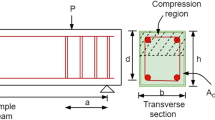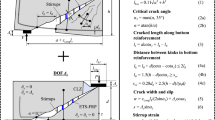Abstract
Shear design of RC beams with and without stirrups using laboratory experiments is difficult or even impossible as a large number of variables need to be considered simultaneously, such as the span-to-depth ratio, web width and reinforcement ratio. In addition, due to the complex shear failure mechanism, empirical approaches for shear design are derived within the boundaries of their own testing regimes. Thus, the generalization ability and applicability of these approaches are limited. To address this issue, this study uses machine learning approaches for shear design. A random forest model is constructed to predict the shear strength of RC beams. The hyperparameters of RF are tuned using beetle antennae search algorithm modified by Levy flight and inertia weight. The developed model is trained on two data sets of RC beams with and without stirrups containing 194 and 1849 samples, respectively. The obtained model has high prediction accuracy with correlation coefficients of 0.9367 and 0.9424 on these two test data sets, respectively. The proposed method is powerful and efficient in shear design of RC beams with and without stirrups and therefore paves the way to intelligent construction.












Similar content being viewed by others
References
Armaghani DJ, Hatzigeorgiou GD, Karamani C, Skentou A, Zoumpoulaki I, Asteris PG (2019) Soft computing-based techniques for concrete beams shear strength. Proc Struct Integr 17:924–933
Asteris PG, Armaghani DJ, Hatzigeorgiou GD, Karayannis CG, Pilakoutas K (2019) Predicting the shear strength of reinforced concrete beams using artificial neural networks. Comput Concr 24(5):469–488
Boddy R, Smith G (2009) Statistical methods in practice: for scientists and technologists. Wiley, Hoboken
Braga-Neto U, Dougherty E (2004) Bolstered error estimation. Pattern Recogn 37(6):1267–1281
Braga-Neto U, Hashimoto R, Dougherty ER, Nguyen DV, Carroll RJ (2004) Is cross-validation better than resubstitution for ranking genes? Bioinformatics 20(2):253–258
Breiman L (2001) Random forests. Mach Learn 45(1):5–32
Bresler B, MacGregor JG (1967) Review of concrete beams failing in shear. J Struct Div 93(1):343–372
Carino N, Leyendecker E, Fattal S (1983) Review of the skyline plaza collapse. Concr Int 5(7):35–42
Chabib HE, Nehdi M, Said A (2006) Predicting the effect of stirrups on shear strength of reinforced normal-strength concrete (NSC) and high-strength concrete (HSC) slender beams using artificial intelligence. Can J Civil Eng 33(8):933–944
Code P (2005) Eurocode 2: design of concrete structures-part 1–1: general rules and rules for buildings. British Standard Institution, London
Collins MP, Bentz EC, Sherwood EG (2008) Where is shear reinforcement required? Review of research results and design procedures. Struct J 105(5):590–600
Committee A. Standardization, I.O.f. (2008) Building code requirements for structural concrete (ACI 318–08) and commentary. American Concrete Institute, Washington
Efron B, Tibshirani RJ (1994) An introduction to the bootstrap. CRC Press, Boca Raton
Fawagreh K, Gaber MM, Elyan E (2014) Random forests: from early developments to recent advancements. Syst Sci Control Eng Open Access J 2(1):602–609
Genuer R, Poggi J-M, Tuleau-Malot C (2010) Variable selection using random forests. Pattern Recogn Lett 31(14):2225–2236
Hastie T, Tibshirani R, Friedman J, Franklin J (2005) The elements of statistical learning: data mining, inference and prediction. Math Intell 27(2):83–85
Hosmer DW Jr, Lemeshow S, Sturdivant RX (2013) Applied logistic regression, vol 398. Wiley, Hoboken
Hyndman RJ, Koehler AB (2006) Another look at measures of forecast accuracy. Int J Forecast 22(4):679–688
Institute AC (2014) Building Code Requirements for Structural Concrete (ACI 318–14): Commentary on Building Code Requirements for Structural Concrete (ACI 318R–14): an ACI Report: American Concrete Institute. ACI, Washington
Jiang X, Li S (2017) BAS: beetle antennae search algorithm for optimization problems. arXiv preprint arXiv:1710.10724.
Kim D, Kim W, White RN (1999) Arch action in reinforced concrete beams—a rational prediction of shear strength. Struct J 96(4):586–593
Kim J-H (2009) Estimating classification error rate: repeated cross-validation, repeated hold-out and bootstrap. Comput Stat Data Anal 53(11):3735–3745
Kohavi R (1995) A study of cross-validation and bootstrap for accuracy estimation and model selection. Ijcai 14:1137–1145
Kuo W, Cheng T, Hwang S (2010) Force transfer mechanism and shear strength of reinforced concrete beams. Eng Struct 32(6):1537–1546
Liaw A, Wiener M (2002) Classification and regression by randomForest. R News 2(3):18–22
MacGregor JG, Wight JK, Teng S, Irawan P (1997) Reinforced concrete: mechanics and design, 3rd edn. Prentice Hall, Upper Saddle River
Mirjalili S, Mirjalili SM, Yang X-S (2014) Binary bat algorithm. Neural Comput Appl 25(3–4):663–681
Neter J, Kutner MH, Nachtsheim CJ, Wasserman W (1996) Applied linear statistical models, 4th edn. Irwin, Chicago
Niwa J, Yamada K, Yokozawa K, Okamura H (1986) Revaluation of the equation for shear strength of reinforced concrete beams without web reinforcement. Doboku Gakkai Ronbunshu 1986(372):167–176
Pavlyukevich I (2007) Lévy flights, non-local search and simulated annealing. J Comput Phys 226(2):1830–1844
Ripley BD (2007) Pattern recognition and neural networks. Cambridge University Press, Cambridge
Russo G, Puleri G (1997) Stirrup effectiveness in reinforced concrete beams under flexure and shear. Struct J 94(3):227–238
Sarsam KF, Al-Musawi JM (1992) Shear design of high-and normal strength concrete beams with web reinforcement. Struct J 89(6):658–664
Shlesinger MF (2006) Mathematical physics: search research. Nature 443(7109):281
Smith K, Vantsiotis A (1982) Shear strength of deep beams. J Proc 79:201–213
Song J, Kang W-H, Kim KS, Jung S (2010) Probabilistic shear strength models for reinforced concrete beams without shear reinforcement. Struct Eng Mech 11(1):15
Stone M (1974) Cross-validatory choice and assessment of statistical predictions. J R Stat Soc Ser B 36:111–147
Sun Y, Zhang J, Li G, Wang Y, Sun J, Jiang C (2019) Optimized neural network using beetle antennae search for predicting the unconfined compressive strength of jet grouting coalcretes. Int J Numer Anal Meth Geomech 43(4):801–813
Sun Y, Zhang J, Li G, Ma G, Huang Y, Sun J, Wang Y, Nener B (2019) Determination of Young's modulus of jet grouted coalcretes using an intelligent model. Eng Geol 252:43–53
Viswanathan GM, Afanasyev V, Buldyrev S, Murphy E, Prince P, Stanley HE (1996) Lévy flight search patterns of wandering albatrosses. Nature 381(6581):413
Yu Q, Bažant ZP (2011) Can stirrups suppress size effect on shear strength of RC beams? J Struct Eng 137(5):607–617
Zhang J, Wang Y (2020) An ensemble method to improve prediction of earthquake-induced soil liquefaction: a multi-dataset study. Neural Comput Applic. https://doi.org/10.1007/s00521-020-05084-2
Zhang T, Visintin P, Oehlers DJ (2015) Shear strength of RC beams with steel stirrups. J Struct Eng 142(2):04015135
Zhang J, Ma G, Huang Y, Sun J, Aslani F, Nener B (2019) Modelling uniaxial compressive strength of lightweight self-compacting concrete using random forest regression. Constr Build Mater 210:713–719
Zhang J, Huang Y, Wang Y, Ma G (2020) Multi-objective optimization of concrete mixture proportions using machine learning and metaheuristic algorithms. Constr Build Mater 253:119208
Zhang J, Huang Y, Ma G, Sun J, Nener B (2020) A metaheuristic-optimized multi-output model for predicting multiple properties of pervious concrete. Constr Build Mater 249:118803
Zhang J, Li D, Wang Y (2020) Toward intelligent construction: prediction of mechanical properties of manufactured-sand concrete using tree-based models. J Clean Prod 258:120665
Zhang J, Li D, Wang Y (2020) Predicting tunnel squeezing using a hybrid classifier ensemble with incomplete data. Bull Eng Geol Environ. https://doi.org/10.1007/s10064-020-01747-5
Zhang J, Huang Y, Ma G et al (2020) Multi-objective beetle antennae search algorithm. arXiv preprint. arXiv:2002.10090
Zsutty TC (1968) Beam shear strength prediction by analysis of existing data. J Proc 65:943–951
Acknowledgements
This study was funded by National Key Research and Development Program (Grant number 2016YFC0600901), China Scholarship Council (Grant number 201706460008), National Natural Science Foundation of China (Grant numbers 51574224, 51704277) and Fundamental Research Funds for the Central Universities (grant number: 2020ZDPY0221).
Author information
Authors and Affiliations
Corresponding author
Ethics declarations
Conflict of interest
The authors declare that they have no competing interests.
Additional information
Publisher's Note
Springer Nature remains neutral with regard to jurisdictional claims in published maps and institutional affiliations.
Electronic supplementary material
Below is the link to the electronic supplementary material.
Rights and permissions
About this article
Cite this article
Zhang, J., Sun, Y., Li, G. et al. Machine-learning-assisted shear strength prediction of reinforced concrete beams with and without stirrups. Engineering with Computers 38, 1293–1307 (2022). https://doi.org/10.1007/s00366-020-01076-x
Received:
Accepted:
Published:
Issue Date:
DOI: https://doi.org/10.1007/s00366-020-01076-x




